Physical Address
304 North Cardinal St.
Dorchester Center, MA 02124
Total knee arthroplasty (TKA) results in improvement in overall quality of life in more than 90% of patients. This remarkable success and factors such as an aging population have led to a dramatic increase in the number of procedures performed and to a corresponding increase in the number of imaging studies obtained for assessment. In addition to radiography, computed tomography (CT), magnetic resonance imaging (MRI), ultrasonography (US), arthrography, and a number of nuclear medicine studies are now available for evaluation of knee arthroplasty. It is the responsibility of both imagers and clinicians to provide the most efficacious and cost-effective examinations in a particular clinical situation. This chapter reviews some available imaging techniques, expected findings in uncomplicated and complicated cases, and the efficacy of various techniques in assessing complications.
Preoperative radiographs often include supine anteroposterior (AP) and lateral and tangential patellar views of the affected knee, as well as standing AP and flexed posteroanterior (PA) views of both knees and an AP standing radiograph of both legs. At the Brigham and Women's Hospital, lateral radiographs are usually obtained cross-table lateral with the knee in maximal extension. When digital radiographs are used, a standard-sized reference object is placed alongside the knee to allow assessment of magnification.
The standing view of both legs allows the mechanical axis (a line drawn from the center of the femoral head to the center of the talus) and anatomical axis (a line drawn along the length of the intramedullary canal of either the femur or the tibia) to be defined. Normally, the mechanical axis passes through the center of the knee or just medial to it, and the angle between the anatomic axis of the femur and the mechanical axis measures 5 to 8 degrees. Standing radiographs of the legs are used to plan the femoral resection, so as to re-create normal mechanical alignment. McGrory et al., however, found that this examination did not significantly aid in obtaining a neutral mechanical axis as compared with performing a standard femoral cut of 5 degrees. Huang et al. found measurement of the mechanical axis to have a variability of 1 to 3 degrees.
Imaging performed immediately after surgery may not be ideal because the radiographs are obtained supine and may not reflect the correct alignment as determined on subsequent standing radiographs. Typically at the Brigham and Women's Hospital, radiographs are instead performed at the first postoperative visit. At that time, both supine radiographs (AP, lateral, and tangential patellar views) and standing radiographs are obtained.
Because coronal malalignment can lead to decreased implant survival and accelerated wear, careful analysis of component position and leg alignment is warranted. Radiographs are an effective means of evaluating component position in sagittal and coronal planes.
Component position on AP and lateral knee radiographs can be assessed as in Fig. 13.1 . The tibial resection is generally perpendicular to the anatomic axis of the tibia. Femoral resection is more complex because of the desire to remove the femur perpendicular to its mechanical axis. Approximately 5 to 8 degrees of valgus is present between the femoral condyles and the anatomic axis of the femur. The posterior/inferior tilt of the tibial component can be assessed on the lateral radiograph. Various axis reference lines have been used for this assessment. Increased down sloping of the tibial component (with posterior cruciate ligament [PCL] retaining components) can increase maximum flexion, but excessive tibial downslope can lead to anterior tibial subluxation, posterior polyethylene (PE) wear, and lack of extension.
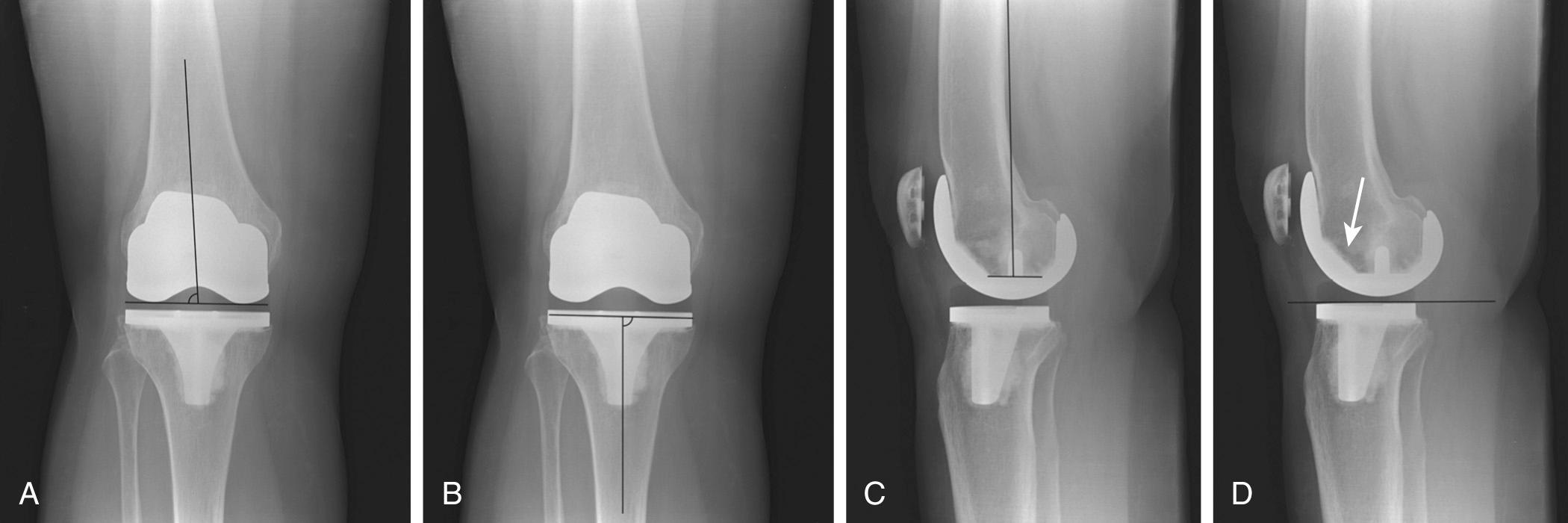
Angulation of the knee in the coronal plane can be measured on standing radiographs of the legs. Conventional radiographs or digital radiographs can be used for this assessment.
A line drawn from the center of the femoral head to the center of the talus (Maquet's line) should intersect the center of the knee ( Fig. 13.2 ). The femoral and tibial components should be perpendicular to this line, and the joint space should be parallel to the ground. Deviations from this alignment should be minimal (within 3 degrees of the normal mechanical axis). Because higher loosening rates have been described in this situation, some authors consider axial malalignment as mechanical alignment outside the range of 1 degree varus to 2 degrees valgus. However, the significance of deviations from this line on implant survival has been questioned.
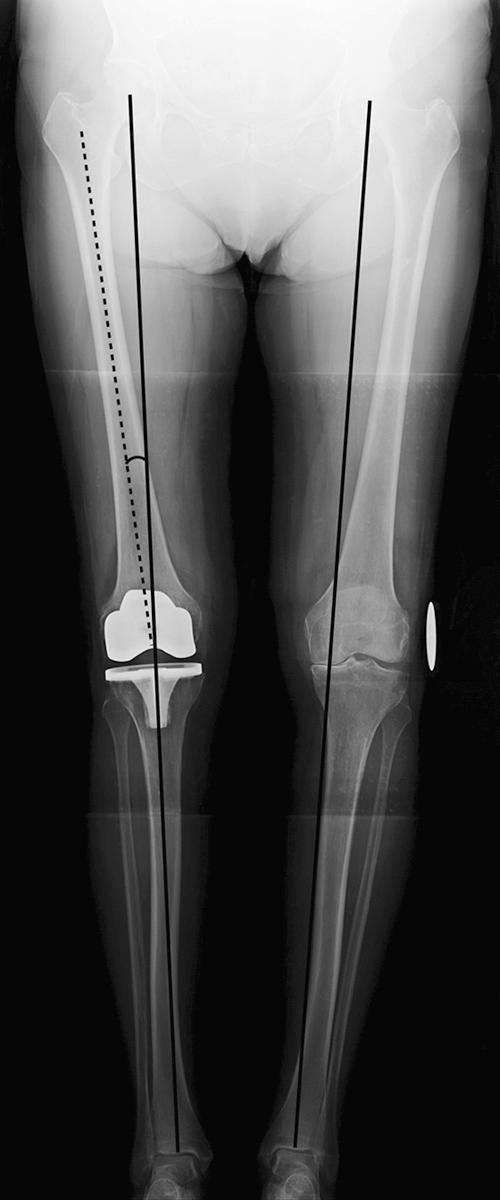
In 1986, Figgie et al. noted that restoration of the tibial patellofemoral relationships had an impact on function in patients receiving posterior stabilized condylar knee prostheses. Change of 8 mm or less in the height of the joint line (JL) (measured as the perpendicular distance from the weight-bearing surface of the tibial plateau to the tibial tubercle) resulted in better functional knee scores, improved range of motion, and absence of patellofemoral pain or mechanical symptoms ( Fig. 13.3 ).
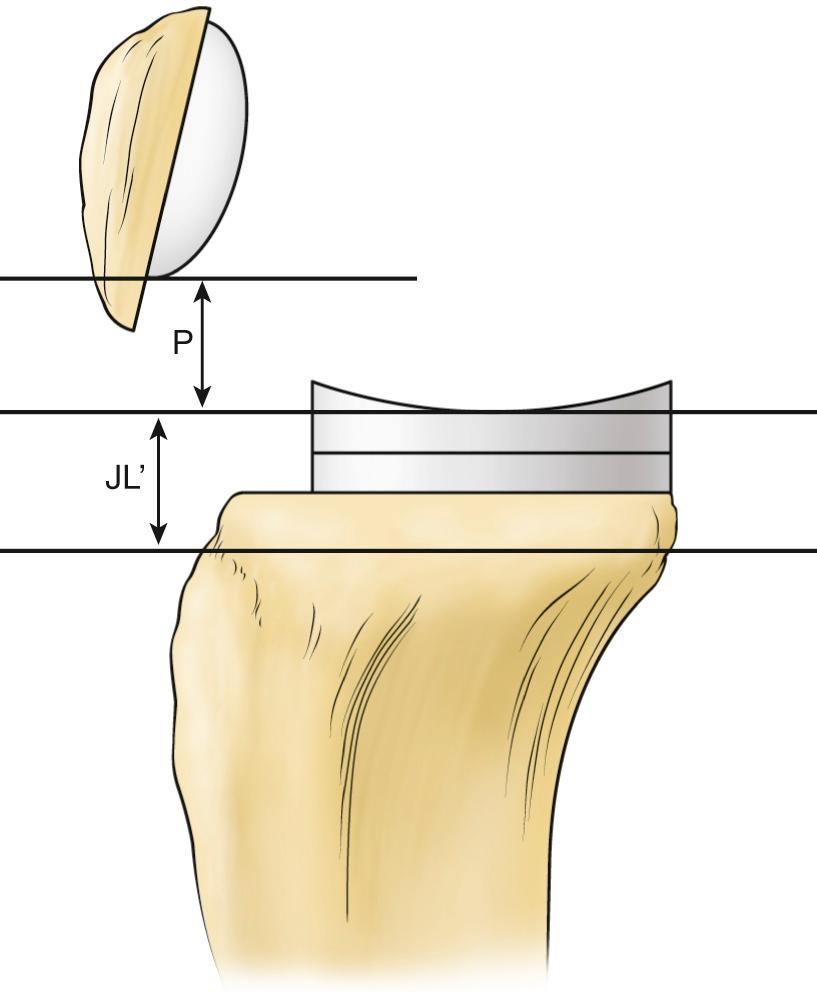
Hofmann et al. used measurements from the adductor tubercle to the JL of the distal femur (in comparison with the normal side or the preoperative radiograph) to assess “proximalization” or “distalization” of the JL ( Fig. 13.4 ). Restoration of the JL to within 4 mm of the preoperative or contralateral side is said to help avoid problems such as patella baja, patella alta, extensor mechanism maltracking, lack of motion, and midflexion instability.
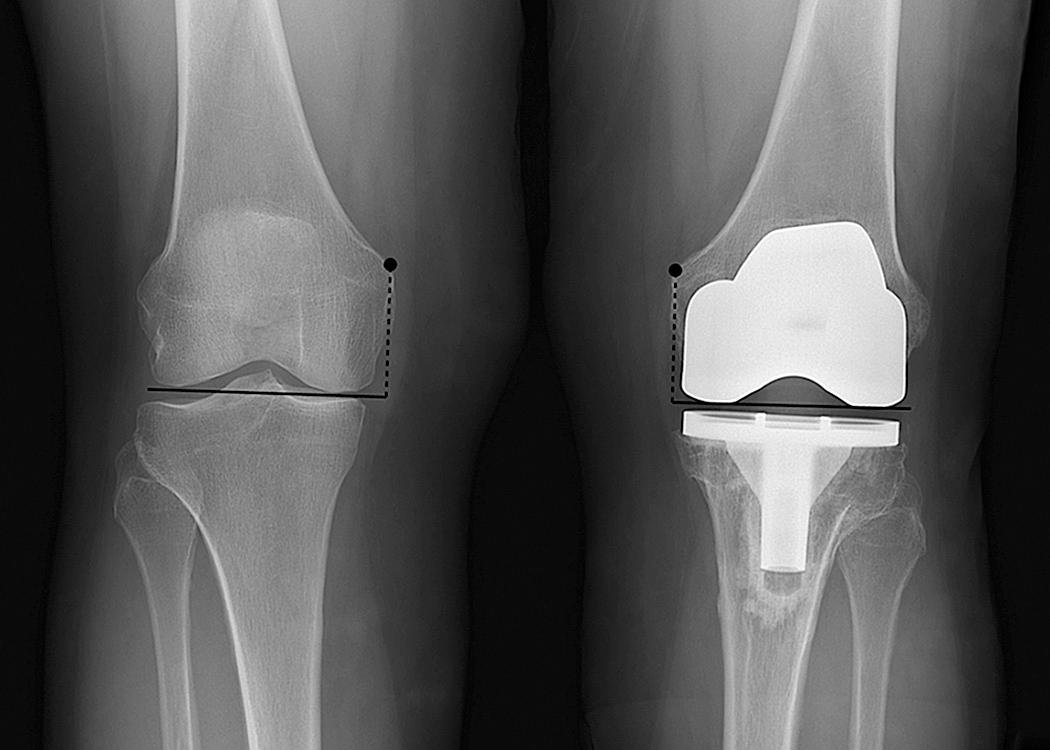
Development of thin radiolucent lines at the bone/cement or bone/prosthesis interface of less than 2 mm within the first 6 months in a cemented implant or during the first 1 to 2 years in noncemented implants without evidence of progression is considered normal ( Fig. 13.5 ). Evaluation of low contact stress TKA with meniscal bearings showed that 99% of radiolucent lines were nonprogressive, but even progressive radiolucent lines did not appear to affect fixation.
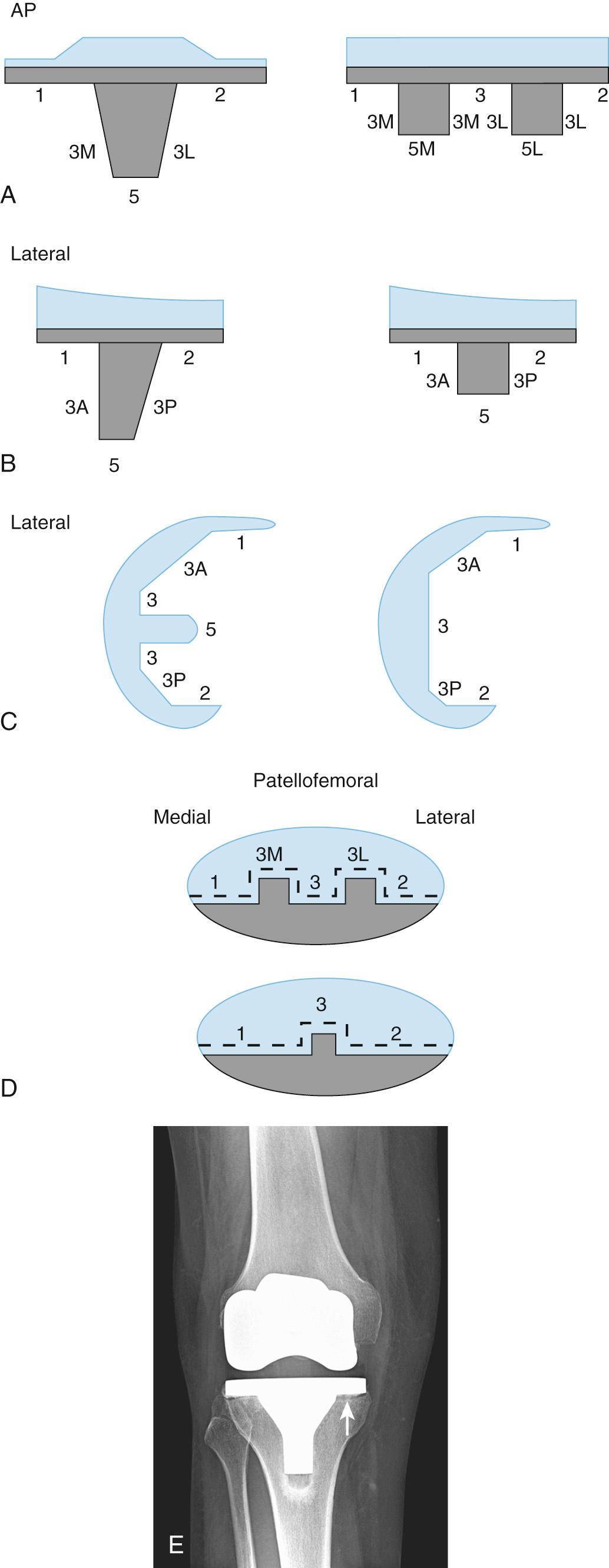
Lucent lines are described by their location (prosthesis-bone, prosthesis-cement, bone-cement), whether they are stable or progressive, and by whether they involve all or part of the interface surface and by their width. They are usually demarcated by an adjacent thin sclerotic line, allowing them to be distinguished from the more poorly defined lucency of osteopenia. A standardized system for monitoring lucent lines developed by The Knee Society delineates specific areas to be assessed (see Fig. 13.5 ). This method is complex, and a simplified system has been proposed.
Areas of decreased stress around femoral or tibial components show a diffuse decrease in bone density. These usually can be distinguished from radiolucent lines by absence of the thin delimiting sclerotic line in areas of stress shielding (see Fig. 13.1 ). Stress shielding develops within the first 2 years after surgery and then remains stable.
The patellofemoral articulation can be an important cause of postoperative knee pain and prosthetic failure. However, the relationship between patellar abnormalities on radiographs and knee symptoms is imperfect.
Both lateral and tangential patellar views are important for assessing the patellar component and alignment. Numerous methods can be used for obtaining tangential patellar views in preoperative or postoperative individuals. Radiographic positioning alterations such as degree of flexion and weight bearing may significantly alter imaging findings. Baldini et al. evaluated weight-bearing tangential patellar radiographs obtained with patients standing and semi-squatting with the knees in 45 degrees of flexion. A correlation was made between anterior knee symptoms and signs and imaging findings. Persistence of patellar tilt of greater than 5 degrees on the patellar dome on the weight-bearing study correlated positively with anterior knee pain. None of the measurements made on non-weight-bearing radiographs correlated with pain and clinical scores.
Radiographic evaluation of the patellofemoral joint includes assessment of patellar tilt, patellar dislocation or subluxation ( Fig. 13.6 ), asymmetry in patellar component positioning, “overstuffing,” patellar height, and patellar fracture. Often postoperative measurements are compared with preoperative ones. CT is helpful in demonstrating patellar fracture, and MRI can be used for delineating soft tissue abnormalities.
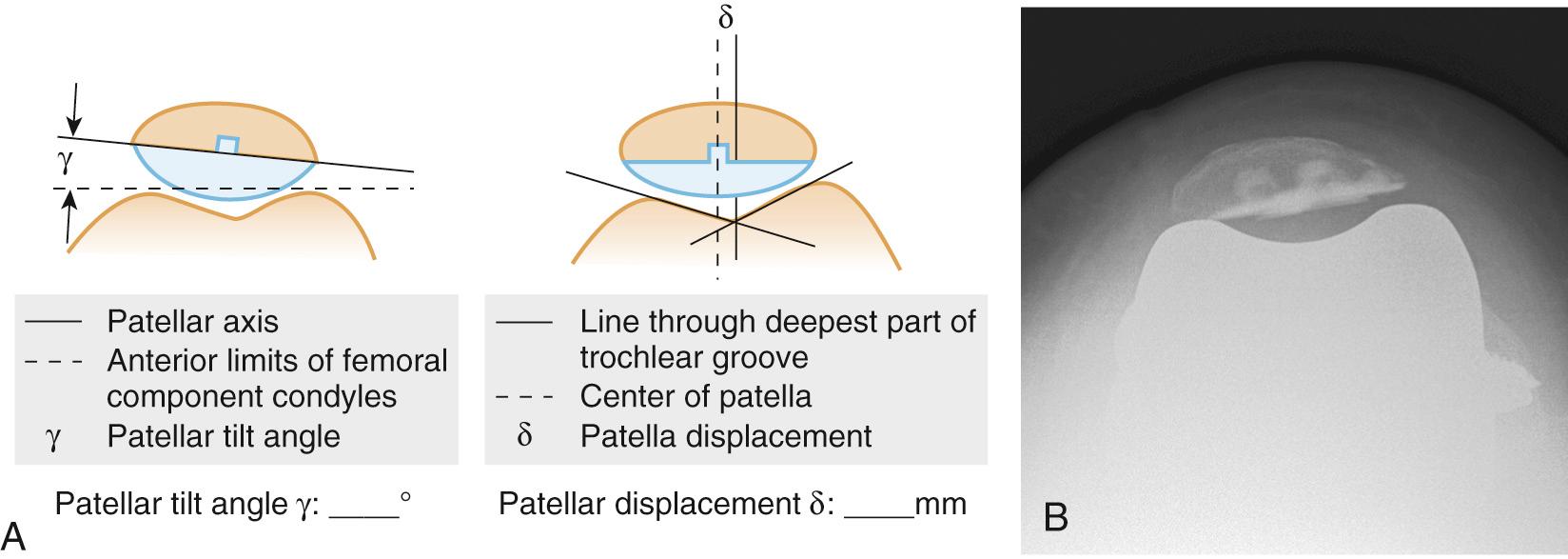
Become a Clinical Tree membership for Full access and enjoy Unlimited articles
If you are a member. Log in here